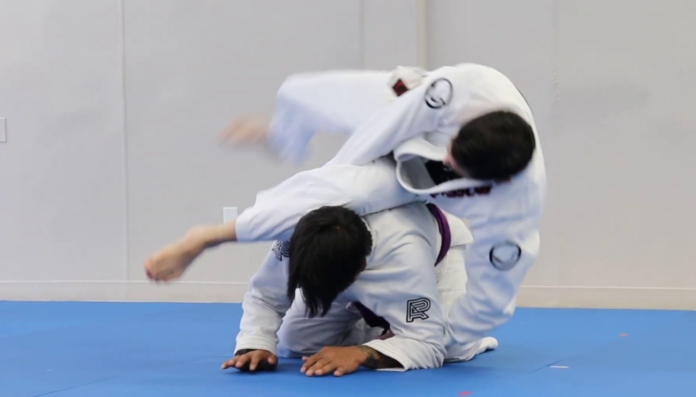
In the BJJ world, you have a huge selection of visually attractive moves to choose from. You can spin, invert, fly, or roll your way into a bunch of different positions or submissions, looking to surprise your opponents. The BJJ Helicopter choke falls within that category.
However, there is an exception to the Helicopter choke that does not apply to most of the above-mentioned flashy moves. Unlike most of them, the choke we’re about to deconstruct today has the potential to work against opponents of any size and experience and won’t land you in trouble if you mess it up. Let’s explain how it all works.
Attacking the Modern BJJ Turtle
The turtle has always been the go-to defense for Judokas but it never really made too much sense for me. Fast forward to the mid-2010s and a modern system of BJJ defense emerged, turning the turtle into the one position that could block all BJJ attacks and open up escapes or counters.
So, how do you now attack a position designed to repel attacks? The main use is that the harder you try to break it down, the more you sacrifice your balance, giving away attachments and options for the bottom person to get out.
Since grabbing underneath the armpit is not an option anymore against any experienced turtle player, you’re left with destabilizing the turtle itself, which is the weakest point of the position. The best way to achieve a turtle breakdown is to target either end of the turtle – the legs or the neck.
When you are grappling with the Gi, the neck becomes your primary target. While attacking with the likes of the clock choke and the helicopter choke might not yield a submission outcome, you will destroy the turtle and set yourself up to have more success with your attacking game. Unless you let the opponent turtle up again.

Rolling Gi Chokes: A Warning
The BJJ Helicopter choke is part of the rolling chokes family, and whenever a world like rolling, spinning, or flying precedes a Brazilian Jiu-Jitsu move, you should exercise caution with it. It has as much to do with your safety as that of your opponent or training partner.
With rolling chokes, there is a point during the drop section of your roll when you have no control over your body. This is the time when you’re past the highest point of the roll and all you can do is let gravity take you to the mats. In ideal circumstances, this is a large reason behind the success of rolling chokes.
In the case of the Helicopter choke, though, you should be careful as this means all your weight is essentially going to drop-hang off the opponent’s neck. Since the Gi is involved, this might result in neck muscle or even spinal injuries before any choking mechanics start to apply.
Since there is no real way of dropping safely while executing a rolling choke, keep in mind that you don’t have to clamp on your grips as if your life depends on it and you should be ready to let go in case you feel that the opponent’s body positioning is not where you expect them to land, or they tap verbally or in a panicked way.
Step-by-Step Breakdown of the Helicopter Choke
The BJJ Helicopter choke is essentially a clock choke done in a way that locks the opponent’s head in place so that they can’t turn to the side and sneak out as they usually do versus clock chokes.
The absolute prerequisite of performing this choke is to establish a thumb-inside grip on the far side of the opponent’s collar while they are turtled up. As you’ll see later, there are ways to use the choke outside of the turtle position, but for learning purposes, it is best if we stick to it.
Grip Positioning
The placement of the choking arm is across a turtled-up opponent’s neck, while you’re positioned to the side. Reaching underneath the chin is not going to be resistance-free, which is why you only need to thread your thumb inside the opponent’s collar.
Your other arm can reinforce the position by grabbing the opponent’s pants on the near side. This way, you can still move freely to eventually set up the helicopter choke while preventing the bottom person from rolling out.
The Arm Post Checkpoint
Getting the Helicopter choke grips in usually has you in a kneeling or half-kneeling position to the side of your opponent. In order to enter the Helicopter choke you’ll need to pop up to standing, which will create space that the opponent can use.
While you should not linger in the standing portion of the choke setup, it actually helps the surprise factor as the opponent wonders why the weight is suddenly off. To ensure you can enter the choke or other follow-ups, you need to post the palm of the hand that held the pants on the opponent’s back.
The Leg Swing
The crucial moment in making the Helicopter choke work and preventing you from completely conceding the bottom position is the leg swing, also known as the stepover. This motion brings the power of your leg muscles into play, as you use the leg that is closer to the opponent to reinforce the choking arm as well as destroy any hopes of posturing up.
In fact, the arm post checkpoint serves as a power source to launch the step over, as you throw your nearside leg over the opponent’s body, trying to place the foot next to their head on the same side as the rest of your body.
This motion where you wrap your leg around your choking arm also activates the rolling motion, and the leg wedges deeper behind the neck as you start to drop to the mats.
Establishing an Underhook
Finally, as you allow the leg swing to take you over the opponent, your goal is to use the free arm, which is the one that is posted on their back to grab an underhook on the far side as you go through the rolling motion.
This aspect of the choke might not be available always, in which case, you should grab whatever you can get a hold of to solidify your position. However, once you get comfortable with the rolling helicopter choke, you’ll find it easy to sneak in an underhook control that further blocks the opponent from moving.
Choke-wise, there is no real need to squeeze anything as the roll and final landing position put immense pressure on the neck via the collars. If you need more pressure, extend the leg that is wedged behind the arm to finish off stubborn opponents.
A Couple Of BJJ Helicopter Choke Variations
Now that you know how to do the Helicopter choke against a turtled-up opponent, let’s look at a few other setups of the choke that are going to catch the eye of experienced grapplers a bit more.
Helicopter Choke From the Back
As an alternative to classic choke attacks from the back, you could opt for the Helicopter choke if you set everything up correctly. The main thing to pay attention to is that you will need to relinquish your hooks in order to get to the choke.
This variation also begins with a tight thumb-in grip on the collar, however, this time you set it up from the back just like you’d do for a bow and arrow choke. Since you don’t need hooks, all it takes is standing up however slightly you need to execute the leg swing.
In this instance, the choke is not a rolling one but rather a falling one, and instead of underhooking the arm on the far side, you’re scooping up the near side knee, again, like in a bow and arrow choke finish.
Judo Style Helicopter Choke Entry form Throws
This variation of the Helicopter choke setup is the one that works the best out of everything in this article. The reason for this is that you set it up during a transition as you attempt a throw or a pass and the opponent decides to turtle up.
Once again, nothing happens without the grips, and you have to have the collar control to set this one up. That said, whenever an opponent turns to enter the turtle, you get your cue to go for the leg swing, allowing you to enter into the choke tightly with a high percentage of success.
The Clock Choke
Finally, we have to pay homage to the predecessor of the Helicopter choke which is the clock choke. This choke has put many people to sleep on account of the fact that you don’t have to use hooks to finish it and most people do not perceive the danger until it is too late.
Finishing the clock choke only requires the thumb-in grip and does not involve standing or rolling. Simply put, you grab the collar, place the weight of your shoulder on the opponent’s back, right below their neck and you start circling, be it clockwise or counterclockwise in the direction of their head.
Chopper Away!
Is the Helicopter choke enough to end all your turtle trouble while you’re rolling or competing in Gi Jiu-Jitsu? Of course not. However, it does present a very viable solution to help you break down the turtle and even maybe sneak in a submission while you are at it.
If you opt to use the choke during transitions through, particularly when you’re using collar-based takedown systems or passes, you open the door to a very powerful finish that often comes underestimated on account of its somewhat acrobatic nature. But, if it’s not flashy it’s not really worth doing, is it?
You Might Also Be Interested in:
What Is The Best BJJ DVD Instructional For Submission Hunters?


![Darce Choke Encyclopedia – Origins, Mechanics and Variations [2025] BJJ, choke, Brabo, BJJ Darce Choke, D'arce Choke, Darce BJJ Choke](https://bjj-world.com/wp-content/uploads/2017/11/JungPoirierLeeYahoo-218x150.jpg)


















![Master The Move Anaconda Strangle John Danaher DVD Review [2025] Master The Move Anaconda Strangle John Danaher DVD Review](https://bjj-world.com/wp-content/uploads/2025/02/anaconda-strangle-john-danaher-dvd-review-324x235.png)
![X-Guard Trickery Kyle Sleeman DVD Review [2025] X-Guard Trickery Kyle Sleeman DVD Review](https://bjj-world.com/wp-content/uploads/2025/03/x-guard-trickery-kyle-sleeman-dvd-review-100x70.png)





![Knee Lever John Wayne Sweep Adam Wardzinski DVD Review [2024] Knee Lever John Wayne Sweep Adam Wardzinski DVD Review](https://bjj-world.com/wp-content/uploads/2024/12/john-wayne-sweep-adam-wardzinski-dvd-review-100x70.png)
![Darces From Everywhere Kade and Tye Ruotolo DVD Review [2024] Darces From Everywhere Kade and Tye Ruotolo DVD Review](https://bjj-world.com/wp-content/uploads/2024/10/darces-from-everywhere-kade-and-tye-ruotolo-dvd-cover-100x70.png)

![Dynamic De La Riva Guard Otavio Sousa DVD Review [2025] Dynamic De La Riva Guard Otavio Sousa DVD Review](https://bjj-world.com/wp-content/uploads/2025/02/dynamic-de-la-riva-guard-otavio-sousa-dvd-review-100x70.png)
![No-Gi Pressure Mastery JT Torres DVD Review [2024] No-Gi Pressure Mastery JT Torres DVD Review](https://bjj-world.com/wp-content/uploads/2024/10/no-gi-pressure-mastery-jt-torres-dvd-review-100x70.png)
![Foot Sweep the World Dainis Nguyen-Huu DVD Review [2024] Foot Sweep the World Dainis Nguyen-Huu DVD Review](https://bjj-world.com/wp-content/uploads/2024/11/foot-sweep-the-world-dainis-nguyen-huu-dvd-review-100x70.png)
![Henry Akins Black Hole No-Gi Closed Guard DVD Review [2024] Henry Akins Black Hole No-Gi Closed Guard DVD Review](https://bjj-world.com/wp-content/uploads/2024/09/henry-akins-black-hole-no-gi-closed-guard-dvd-review-100x70.png)

![Higher Tripod Passing Craig Jones DVD Review [2025] Higher Tripod Passing Craig Jones DVD Review](https://bjj-world.com/wp-content/uploads/2025/02/higher-tripod-passing-craig-jones-dvd-review-100x70.png)
![Feet Finder Foot Sweeps Christian Ozbek DVD Review [2024] Feet Finder Foot Sweeps Christian Ozbek DVD Review](https://bjj-world.com/wp-content/uploads/2024/09/feet-finder-foot-sweeps-christian-ozbek-dvd-review-100x70.png)

![Double Sleeve Guard Jon Thomas BJJ DVD Review [2024] Double Sleeve Guard Jon Thomas BJJ DVD Review](https://bjj-world.com/wp-content/uploads/2024/10/double-sleeve-guard-jon-thomas-bjj-dvd-review-100x70.png)
![Total Domination Top Control Mariusz Domasat DVD Review [2024] Total Domination Top Control Mariusz Domasat DVD Review](https://bjj-world.com/wp-content/uploads/2024/09/domination-top-control-mariusz-domasat-dvd-review-100x70.png)
![Giancarlo Bodoni DVD Bundle Essential Connections Full Review [2024] Giancarlo Bodoni DVD Bundle Essential Connections Full Review](https://bjj-world.com/wp-content/uploads/2024/09/giancarlo-bodoni-dvd-bundle-essential-connections-100x70.png)


![Tiny Woman Guide To The Guard Ann Kneib DVD Review [2024] Tiny Woman Guide To The Guard Ann Kneib DVD Review](https://bjj-world.com/wp-content/uploads/2024/11/tiny-woman-guide-to-the-guard-ann-kneib-dvd-review-100x70.png)

![Slip N Slide Into Victory Julián Espinosa DVD Review [2025] Slip N Slide Into Victory Julián Espinosa DVD Review](https://bjj-world.com/wp-content/uploads/2025/01/slip-n-slide-into-victory-julian-espinosa-dvd-review-100x70.png)
![Charles Allan Price Building Workouts For BJJ DVD Review [2024] Charles Allan Price Building Workouts For BJJ DVD Review](https://bjj-world.com/wp-content/uploads/2024/09/charles-allan-price-building-workouts-for-bjj-review-100x70.png)
![Grappling Takedown Dominance Brandon Ruiz DVD Review [2025] Grappling Takedown Dominance Brandon Ruiz DVD Review](https://bjj-world.com/wp-content/uploads/2025/01/grappling-takedown-dominance-brandon-ruiz-dvd-review-100x70.png)